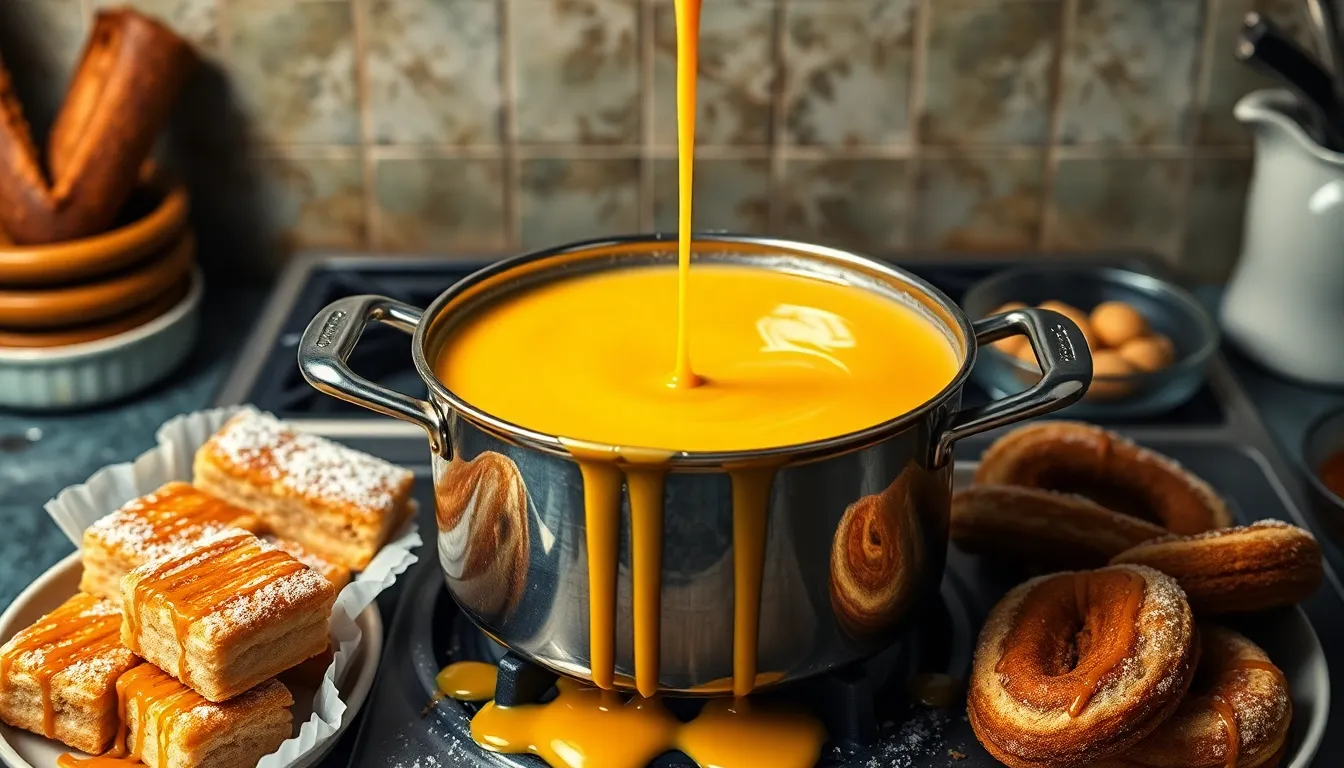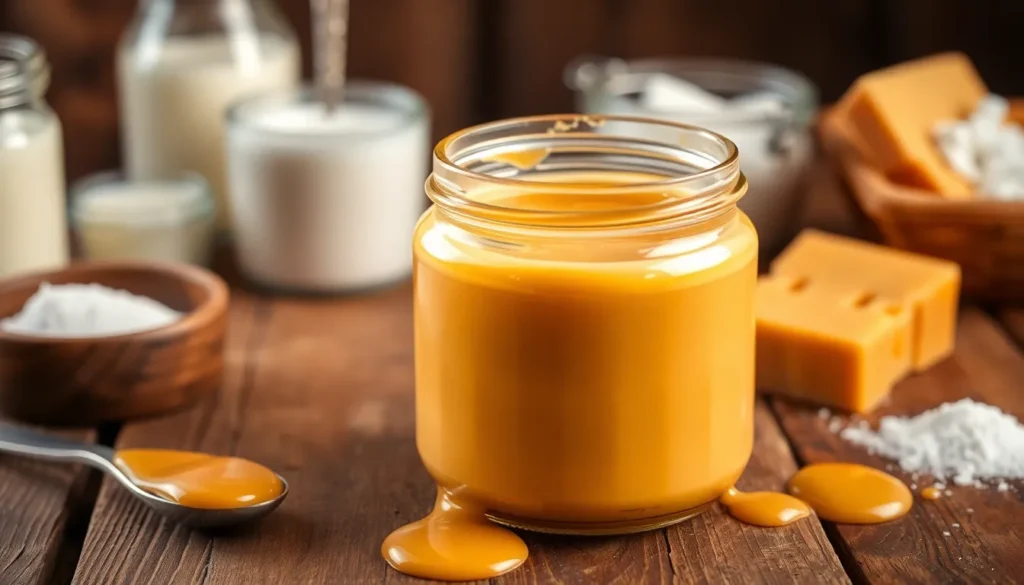Dulce de leche is a sweet, creamy treat beloved in many cultures, especially in Latin America. This luscious caramel-like sauce is made by slowly heating sweetened milk until it transforms into a rich, golden confection. Its smooth texture and rich flavor make it a versatile ingredient, perfect for drizzling over desserts, spreading on toast, or simply enjoying by the spoonful.
Originating in countries like Argentina and Mexico, dulce de leche has become a staple in various cuisines. Its popularity continues to grow worldwide, captivating dessert lovers with its unique taste. Whether used in cakes, pastries, or ice creams, this delightful delicacy adds a touch of indulgence to any dish. Discovering the magic of dulce de leche opens the door to a world of sweet possibilities.
Table of Contents
ToggleWhat Is Dulce De Leche?
Dulce de leche is a creamy, caramel-like sauce made by slowly heating sweetened milk. This traditional Latin American treat develops a rich, golden color and a smooth, velvety texture during the cooking process.
Origins of dulce de leche trace back to countries like Argentina and Mexico, where it holds cultural significance. The simple combination of milk and sugar transforms into a versatile ingredient.
Dulce de leche serves various culinary purposes. It enhances desserts such as cakes and pastries, complements ice creams, and makes a delightful spread for toast. Chefs and home cooks often experiment with it, incorporating it into diverse recipes.
Dulce de leche’s global popularity continues to grow, appealing to those who appreciate its sweet, indulgent flavor and creamy consistency.
History of Dulce De Leche

Dulce de leche’s history reflects its deep roots in Latin American culture. This beloved treat has evolved over centuries, showcasing its significance across various regions.
Origins and Cultural Significance
Dulce de leche originated in the early 19th century, with competing claims mainly from Argentina, Mexico, and Uruguay. Each country celebrates its unique variations. In Argentina, dulce de leche is a staple in traditional desserts, often associated with celebrations. In Mexico, it appears as cajeta, made with goat’s milk, reflecting regional preferences. Its cultural importance is evident in literature, festivals, and culinary practices, where it symbolizes tradition and shared heritage.
Evolution Over Time
Dulce de leche has evolved significantly since its inception. Initially prepared using basic methods, its production techniques improved alongside advances in cooking. With the introduction of thermometers and modern cookware, achieving the desired texture became more accessible. In the 20th century, mass production emerged, allowing for wider distribution. Today, artisanal versions thrive alongside industrial products, offering diverse options for consumers. Its incorporation into international cuisines further solidifies its global appeal, making dulce de leche a versatile treat for all.
Ingredients Used in Dulce De Leche
Dulce de leche primarily consists of a few key ingredients that create its signature flavor and texture. Understanding these components offers insight into the preparation and variations of this beloved treat.
Milk Variations
Milk serves as the foundation for dulce de leche. Common types used include:
- Cow’s Milk: This is the most widely used milk for traditional dulce de leche, producing a creamy consistency.
- Goat’s Milk: In recipes like cajeta, goat’s milk delivers a unique flavor profile and a slightly tangy note.
- Condensed Milk: Some recipes replace fresh milk with sweetened condensed milk. This alternative simplifies the process while enhancing sweetness.
Each milk variation contributes differently to the final product’s taste and texture.
Sweeteners and Flavorings
Sweeteners enhance the caramelization process in dulce de leche. Common choices include:
- Granulated Sugar: Regular sugar provides sweetness and aids in achieving the characteristic caramel color.
- Brown Sugar: This option adds a deeper flavor, thanks to its molasses content.
- Honey or Agave Syrup: These natural sweeteners can impart additional layers of flavor and may offer a different texture.
Flavorings often accompany sweeteners for richness. Common additions include:
- Vanilla Extract: This enhances the sweetness and aroma of dulce de leche.
- Salt: A pinch of salt balances the sweetness and enhances overall flavor complexity.
These ingredients enrich dulce de leche, making it versatile for numerous culinary applications.
How to Make Dulce De Leche
Making dulce de leche involves simple ingredients and techniques that yield a delicious outcome. Both traditional and modern methods exist, each with unique procedures and benefits.
Traditional Methods
Traditional methods typically involve only two ingredients: milk and sugar. The process starts by combining these ingredients in a heavy-bottomed pot. The mixture is brought to a gentle simmer over low heat, stirring continuously to prevent sticking or burning.
- Simmering time: Simmer for 1 to 2 hours until the color darkens to a rich caramel hue.
- Stirring: Stir constantly to ensure even cooking and prevent scorching.
- Cooling: Once the desired consistency is achieved, remove from heat and allow it to cool before transferring to a jar.
This method highlights the traditional craftsmanship of dulce de leche, showcasing its rich flavor profile.
Modern Techniques
Modern techniques often simplify and expedite the process of making dulce de leche. These methods may involve the use of sweetened condensed milk or pressure cookers.
- Sweetened condensed milk: Pour a can into a saucepan and heat over medium-low for about 30 to 40 minutes while stirring regularly.
- Pressure cooker: Place a can of sweetened condensed milk in a pressure cooker covered with water. Cook at high pressure for 40 minutes, then allow it to cool completely before opening.
These modern approaches streamline the preparation while still delivering a satisfying and creamy dulce de leche.
Uses of Dulce De Leche
Dulce de leche serves as a versatile ingredient in many culinary applications. Its rich flavor and creamy texture enhance a variety of dishes, making it a favorite among chefs and home cooks alike.
Culinary Applications
- Spread: Dulce de leche serves as an indulgent spread for toast, pancakes, and waffles, providing a delightful sweetness that complements breakfast items.
- Filling: Dulce de leche acts as a filling for desserts, such as cakes, cupcakes, and pastries. It offers a luscious center that pairs well with other flavors.
- Sauce: Dulce de leche serves as a rich sauce drizzled over ice cream, fruit, or cheesecakes, transforming simple desserts into extraordinary treats.
- Ingredient: Dulce de leche functions as a key ingredient in numerous recipes, including fudge, brownies, and cookies, adding depth and sweetness.
Popular Dishes Featuring Dulce De Leche
- Alfajores: Alfajores are traditional cookies layered with dulce de leche, often coated in powdered sugar or chocolate. They highlight the treat’s rich flavor.
- Flan: Flan, a classic custard dessert, often features a layer of dulce de leche on top, enhancing its caramel notes and creating a visually appealing presentation.
- Chocotorta: Chocotorta is a no-bake Argentine dessert made with chocolate cookies, dulce de leche, and cream cheese. It showcases the versatility of dulce de leche in cold desserts.
- Dulce de Leche Ice Cream: This popular treat combines creamy vanilla or chocolate ice cream swirled with dulce de leche, providing a rich, satisfying flavor.
With these diverse uses, dulce de leche continues to inspire creativity in the kitchen, enriching culinary experiences across cultures.
Dulce de leche stands out as a beloved treat that transcends borders and traditions. Its rich history and cultural significance make it more than just a dessert; it’s a symbol of shared heritage and culinary creativity. Whether enjoyed as a simple spread or incorporated into elaborate desserts, its versatility is undeniable.
With countless recipes and variations available, dulce de leche invites everyone to explore its delightful flavors. From traditional methods to modern adaptations, this sweet sauce continues to inspire chefs and home cooks alike. Embracing dulce de leche opens up a world of indulgence and creativity in the kitchen, making it a staple for any dessert lover.






